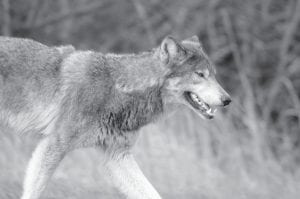At press time, 73 gray wolves had been taken in Minnesota’s first wolf hunt in nearly 40 years. The majority of wolves killed have been in the northeast zone, which is encompasses much of Cook County. The Minnesota Department of Natural Resources (DNR) will evaluate the effect of the hunt on the wolf population after the season ends to determine whether or not a second hunt will be held next year.

Seventy-three gray wolves were taken over the first five days of Minnesota’s first wolf hunt held in nearly 40 years, 30 of them from the northeast zone, which encompasses much of Cook County.
The season coincides with Minnesota’s firearm deer hunting season and is being conducted in three zones. A quota of 200 wolves has been allowed for those zones by the DNR for what is being called the early season, which ends November 17, the last day of deer rifle hunting.
A second hunt will begin November 24 and will continue through January 31. During the second season hunters will be allowed to shoot or trap wolves. Again, a maximum of 200 wolves will be allowed to be harvested. Combined, both seasons could see the taking of 400 wolves from Minnesota’s forests. The second season ends January 24.
As of Monday, November 5, hunters had recorded 8 wolf kills in the east central zone and the DNR suspended the season for that area. The EC zone had a limit of 9 wolves.
According to the Minnesota DNR website, 36 wolves were taken the first day.
The first wolf registered in the state was brought into Buck’s Hardware Hank on opening day. The hunter, who said it suffered from mange and weighed about 80 pounds, shot it and planned to have the head mounted.
Tribal lands throughout the state, including lands owned and managed by the Grand Portage Band of Lake Superior Chippewa, are closed to wolf hunting because wolves hold spiritual significance for the Ojibwe.
By Wednesday, November 7, 35 wolves had been taken in the northwest zone, where the quota is 133.
More than 24,000 people applied to take part in a lottery to select 3,600 hunters. Hunters selected paid $30 for a license to take part in what has been up to now a contentious issue. Several environmental and wildlife advocacy groups have held protests and filed lawsuits to halt the hunt, but the courts rejected their overtures and the season began on time.
The DNR says it is conducting the hunt to thin the wolf population. Wildlife researchers estimate the adult wolf population in Minnesota at about 3,000 wolves. As many as 5,000 wolves may roam the forest after pups are born, but due to disease, starvation and predation the numbers drop into the 3,000 range.
The Endangered Species Act federally protected Minnesota’s wolves until January 27, 2012, when the Minnesota DNR took over their management.
The DNR will evaluate the effects of the hunt on the wolf population after the season and determine if a second hunt will be held next year.


Loading Comments